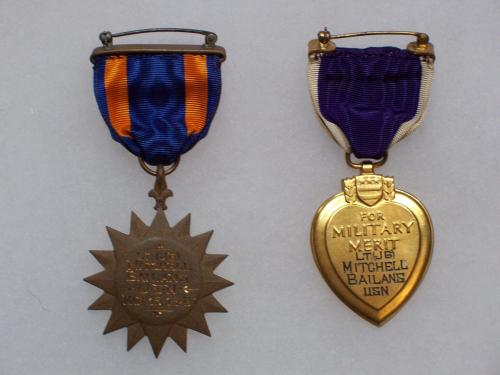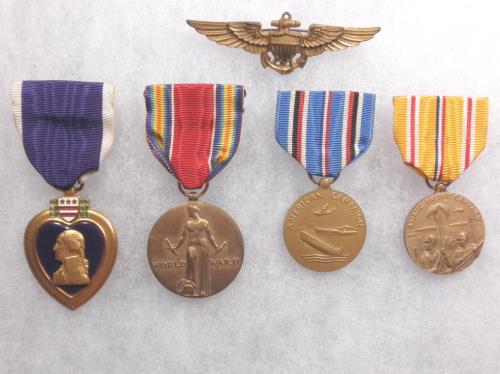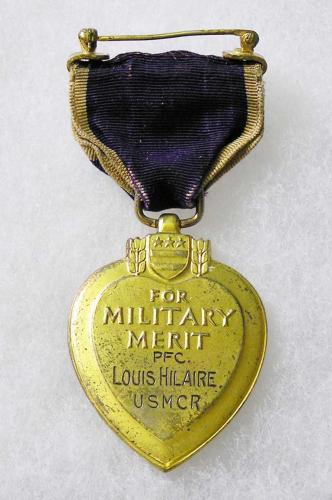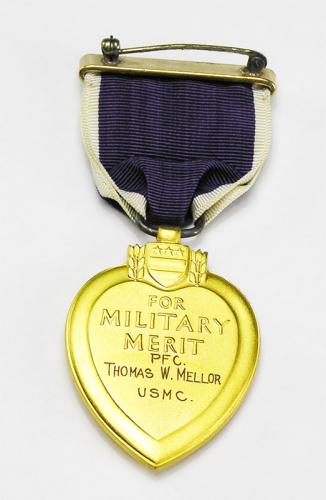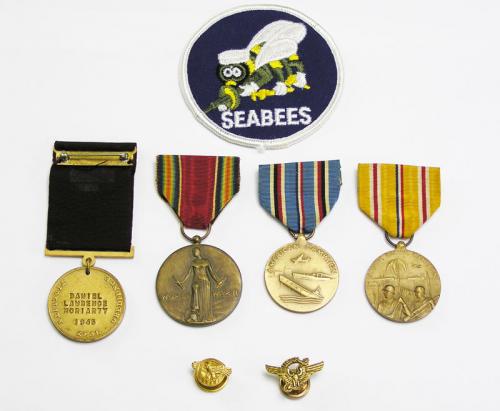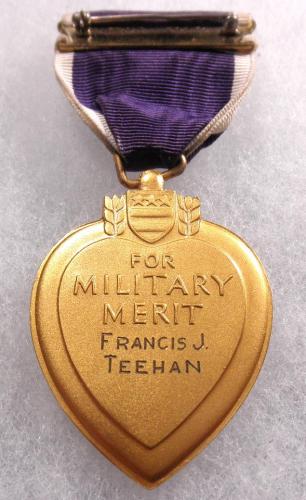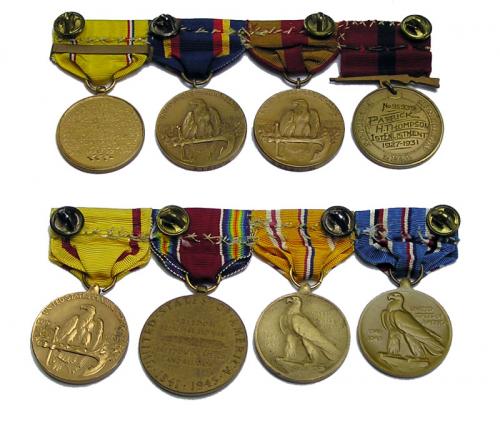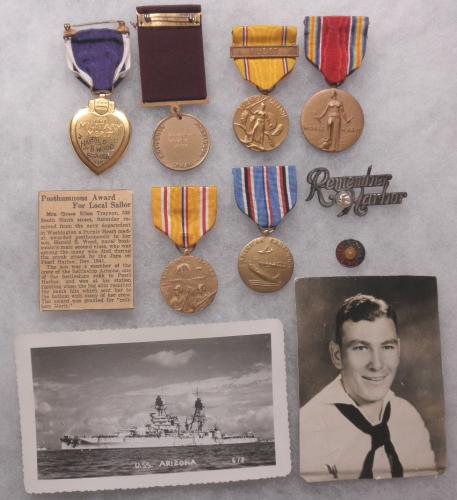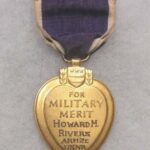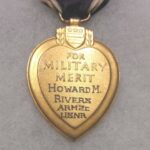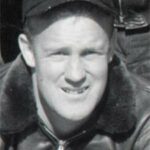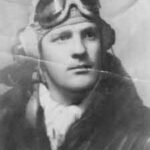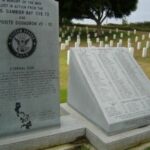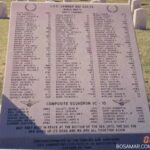Howard Martin Rivers was born July 13, 1921 in Cleveland, Ohio, the son of Aloe and Eva Rivers. He enlisted in the Navy January 23, 1942 as Apprentice Seaman. He went to Aviation school at Alemeda Naval Air Station on February 3, 1942. He entered class on April 1 for a 16 week period. At the end of that period he was qualified for duty as Radioman. He was appointed ARM3c on April 16, 1942, and later reported to the USS Saratoga as ARM2c on October 20, 1942 thus becoming part of Bombing Squadron Eleven. He served in that capacity until August, 1943. He was then was authorized to wear the Air Crew Insignia with 3 stars. During that time they were in the Guadalcanal campaign. On September 12, 1943, he was transferred to the Seattle Naval Air Station, CASU #7, for duty in Composite Squadron Ten. He was then transferred to the USS Gambier Bay, CVE 73, VC-10 on April 4, 1944.
ARM2c Rivers flew his last mission off Gambier Bay on June 17, 1944 in the company of AOM3c Jack Bacon and Ensign Jesse Holleman, the pilot of his TBM, during a flight to bomb the town of Garapan on Saipan. Their plane was BUNO 25537, and was hit by AA and set afire. The pilot guided the plane out to Tanapag Harbor where he successfully ditched in the sea close to shore. On landing, the pilot discovered that both Rivers and Bacon were not there. Apparently they had bailed out, never to be seen again. Holleman suffered burns and was picked up by a landing craft and taken to a hospital ship and later sent stateside.
ARM2c River's group includes his officially engraved Type 2 posthumous Purple Heart with its short titled presentation box and copies of all his official records from St. Louis, plus internet research.
The book "The Men of the Gambier Bay" by Edwin Hoyt is a great history of the Gambier Bay and VC-10. The story about Saipan above comes from that book. Included below is the KIA list for the VC-10 aircrews that was found in that book and on the web:
Composite Squadron VC-10 Personnel KIA in WW2 up to & including the sinking of Gambier Bay
The first VC-10 casualty was Ensign Hovey Seymour who failed to make a deck landing and went into the sea off the coast of California on March 2, 1944 during training on the USS Altamaha, CVE-19. His crew was saved.
The second VC-10 casualty was ARM3C Paul E. Collins, who was killed by drowning when Lt. Bob Weatherholt piloting a TBM could not make the landing and went into the sea. Collins was his radioman and failed to surface after the water landing on June 6, 1944 during exercises, shortly after departing Pearl Harbor.
The first air battle casualties occurred on June 18, 1944 over Saipan. The TBM piloted by Lt. Jesse Holleman was hit by ground fire and was set ablaze. Holleman steered the plane a safe distance off shore and ditched. When he landed, there was no sign of his 2 crew members who apparently bailed out over land. Holleman was badly burned and was picked up and taken to a hospital ship and then was sent back to the States. When his crew mates returned to San Francisco in November, they found him still recovering in the Mare Island hospital. The lost crew members were AMM2C Jack D. Bacon and ARM2C Howard M. Rivers. It is Rivers' purple that is shown here.
The next casualty was at about 0630 on June 19, 1944 when the fighter piloted by LT(jg) Dean W. Gilliatt was launched and crashed into the sea on takeoff. He was not recovered. Four other fighters were successfully launched at that time.
On July 17, 1944, the next casualty is listed as AMMP2C Larry B. Ransom. No historical data could be found about the cause of his death. He is buried in his hometown of Topeka, so that means his body was recovered, further compounding the mystery.
On July 22, 1944, the TBM piloted by Lt(jg) John P. Sanderson, Jr., with ARM3C Jack Richards and AMM2C William L. Zanon was launched by catapult and immediately nose dived into the sea just ahead of the bow of the ship. The depth charges that they had on board exploded and they were all killed.
The following casualties occurred on October 25 and 26 when the Gambier Bay was sunk by Japanese Naval gunfire:
Lt(jg) William T. Gallagher, pilot, and his crew AMM3C Leonard Holly and ARM2C George M. Saint were hit by AA early on Oct. 25, and forced to ditch. Gallagher was awarded the Navy Cross for the action leading up to the ditching when he was credited with attacking and hitting an enemy battleship. They were seen in a raft in the water after ditching, but as the battle progressed, they were not seen again. The NC Award states that the date was Oct. 24, but that does not agree with historical data.
Lt(jg) Walter A. Dahlen was picked up by the destroyer USS Heerman on October 24 following a splash down due to a missed approach. He was on board that ship the morning of Oct. 25 and killed by a shell that hit the bridge. At that time, the ship's captain had left the bridge, so he escaped injury.
LCDR Wayne H. Stewart , flight surgeon, was killed by shrapnel from a shell that landed near him while he attending a wounded sailor on the flight deck at the upper first aid station.
Ensign John S. Phipps was one of the ten pilots who did not depart the ship on the morning of October 25, due to lack of available aircraft. He was presumed killed on board by the shelling before the ship sank.
Lt. Vereen M. Bell survived the sinking, but died on October 26 as he swam away from the group of survivors, and was never seen again.
ARM3C Rudolph S. Gardner is listed as KIA on October 26, 1944 in the ABMC records. This would indicate that he survived the sinking, but was one of those that died at sea waiting for rescue.
The rescue of Gambier Bay and VC-10 personnel did not occur until late on October 26, and as a result, a number of men died in the water, waiting for the delayed rescue.
